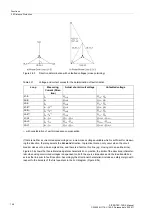
Functions
2.5 Distance Protection
SIPROTEC, 7SD5, Manual
C53000-G1176-C169-5, Release date 02.2011
133
In earthed power systems the earth fault detection can be complemented by a zero sequence voltage detection
function. You can determine whether an earth fault is detected when a zero sequence current or a zero se-
quence voltage threshold is exceeded or when both criteria are met.
3I0> OR 3U0>
(default setting) applies
at address
1509
E/F recognition
if only one of the two criteria is valid. Select
3I0> AND 3U0>
to activate
both criteria for earth-fault detection. This setting can only be changed in DIGSI at
Display Additional Set-
tings
. If you want to detect only the earth current, set
3I0> OR 3U0>
and also
3U0> Threshold
(address
1504
) to
∞
.
Note
Under no circumstances set address
1504
3U0> Threshold
to
∞
, if you have set address
1509
E/F
recognition
=
3I0> AND 3U0>
, or earth-fault detection will no longer be possible.
In compensated or isolated networks, an earth pickup is only initiated after the pickup of the zero-sequence
current criterion. Use the zero-sequence voltage criterion with the parameter
1505
3U0> COMP/ISOL.
for the
confirmation of an earth pickup in case of double earth faults with current transformer saturation.
If the current transformer is saturated and the parameter
1505
is not set to
∞
, an earth fault detection by means
of the I0 criterion alone is not possible and a verification of the pickup by means of the U0 criterion is initiated.
Address
1523
Uph-ph unbal.
allows you to specify how large the asymmetries may become due to load
and 1-pole earth fault conditions.
If the earth fault detection by the I0 criterion threatens to pick up due to fault inception transients following the
occurrence of a single earth fault, the detection can be delayed by means of a parameter
T3I0 1PHAS
(ad-
dress
1218
).
Please note that the parameter
T3I0 1PHAS
is also used by the differential protection function. The setting
that you make here affects the differential protection function as well (see also Section 2.3.2 under margin
heading „Delay Times“).
Application with series-compensated lines
In applications for, or in the proximity of, series-compensated lines (lines with series capacitors) address
1508
SER-COMP.
is set to
YES
, to ensure that the direction determination operates correctly in all cases. The influ-
ence of the series capacitors on the direction determination is described in Section 2.5.2 under margin heading
„Direction Determination in Case of Series-compensated Lines“.
Start of Delay Times
As was mentioned in the description of the measuring methods, each distance zone generates an output signal
which is associated with the zone and the affected phase. The zone logic combines these zone fault detections
with possible further internal and external signals. The delay times for the distance zones can be started either
all together on general fault detection by the distance protection function, or individually at the moment the fault
enters the respective distance zone. Parameter
Start Timers
(address
1510
) is set by default to
on Dis.
Pickup
. This setting ensures that all delay times continue to run together even if the type of fault or the select-
ed measuring loop changes, e.g. because an intermediate infeed is switched off. It is also the preferred setting
if other distance protection relays in the power system are working with this start timing. Where grading of the
delay times is especially important, for instance if the fault location shifts from zone Z3 to zone Z2, the setting
on Zone Pickup
should be chosen.
Angle of inclination of the tripping characteristics
The shape of the tripping characteristic is determined among others by the inclination angle
Distance Angle
(address
1511
). Details about the tripping characteristics can be found in Section 2.5.2 and 2.5.3. Usually, the
line angle is set here, i.e. the same value as in address
1105
Line Angle
(Section 2.1.4.1). Irrespective of
the line angle it is, however, possible to select a different inclination angle of the tripping characteristic.
















































